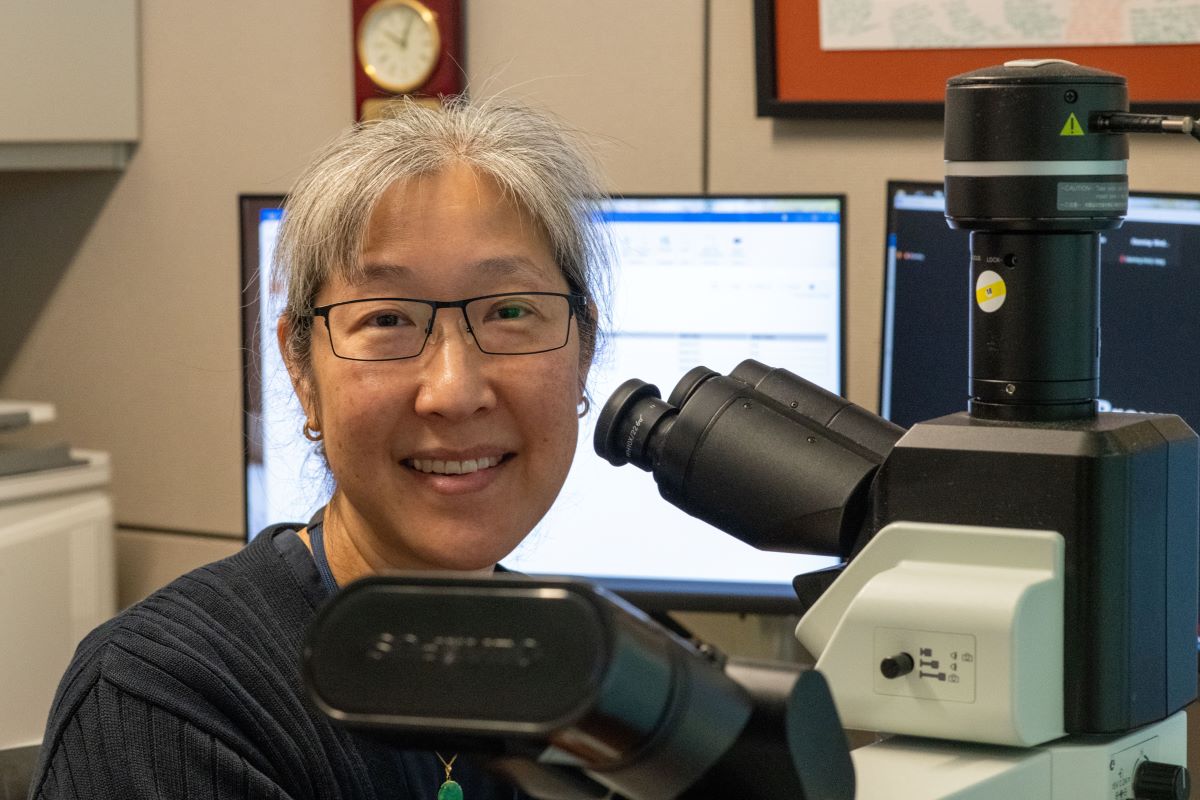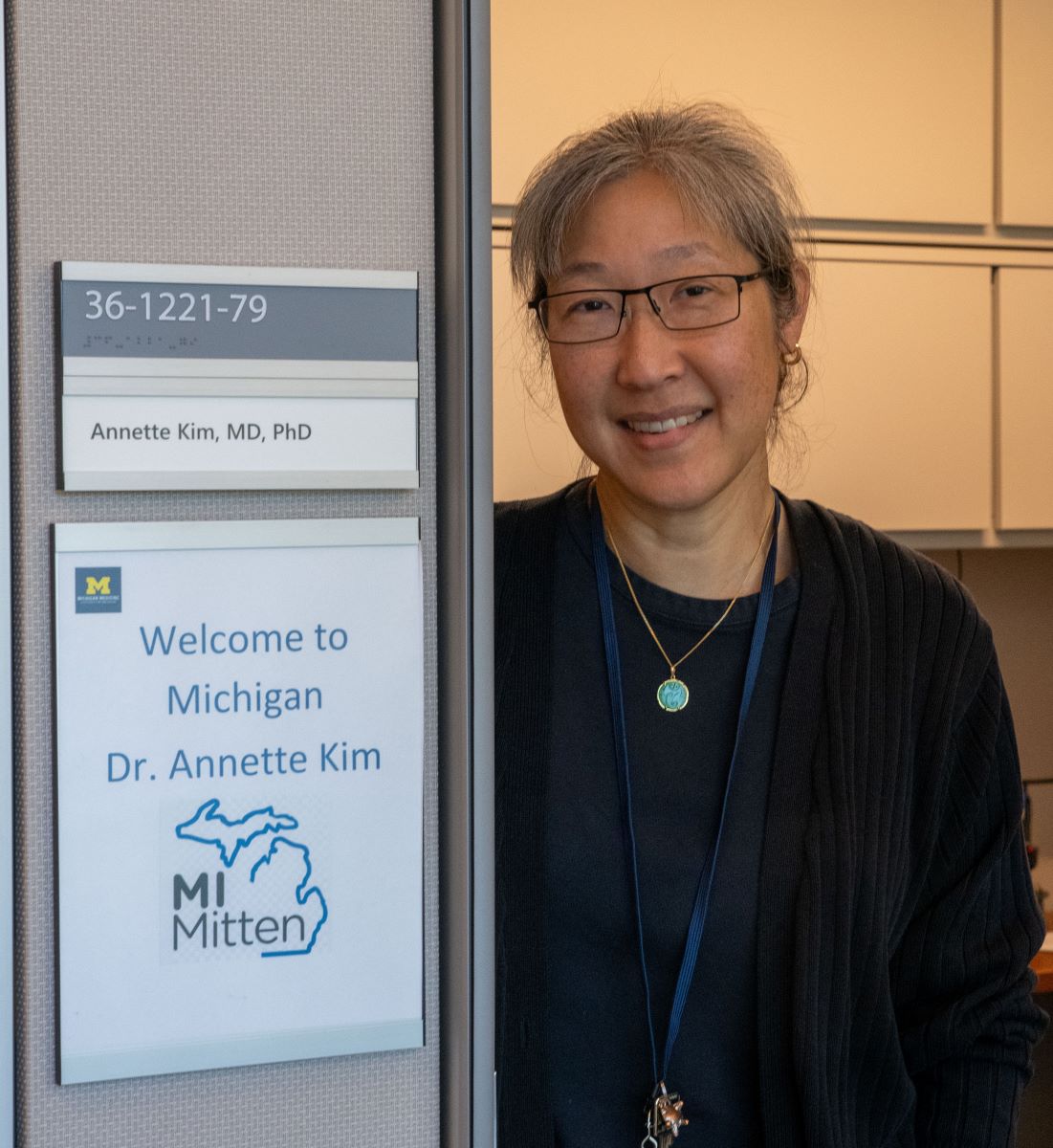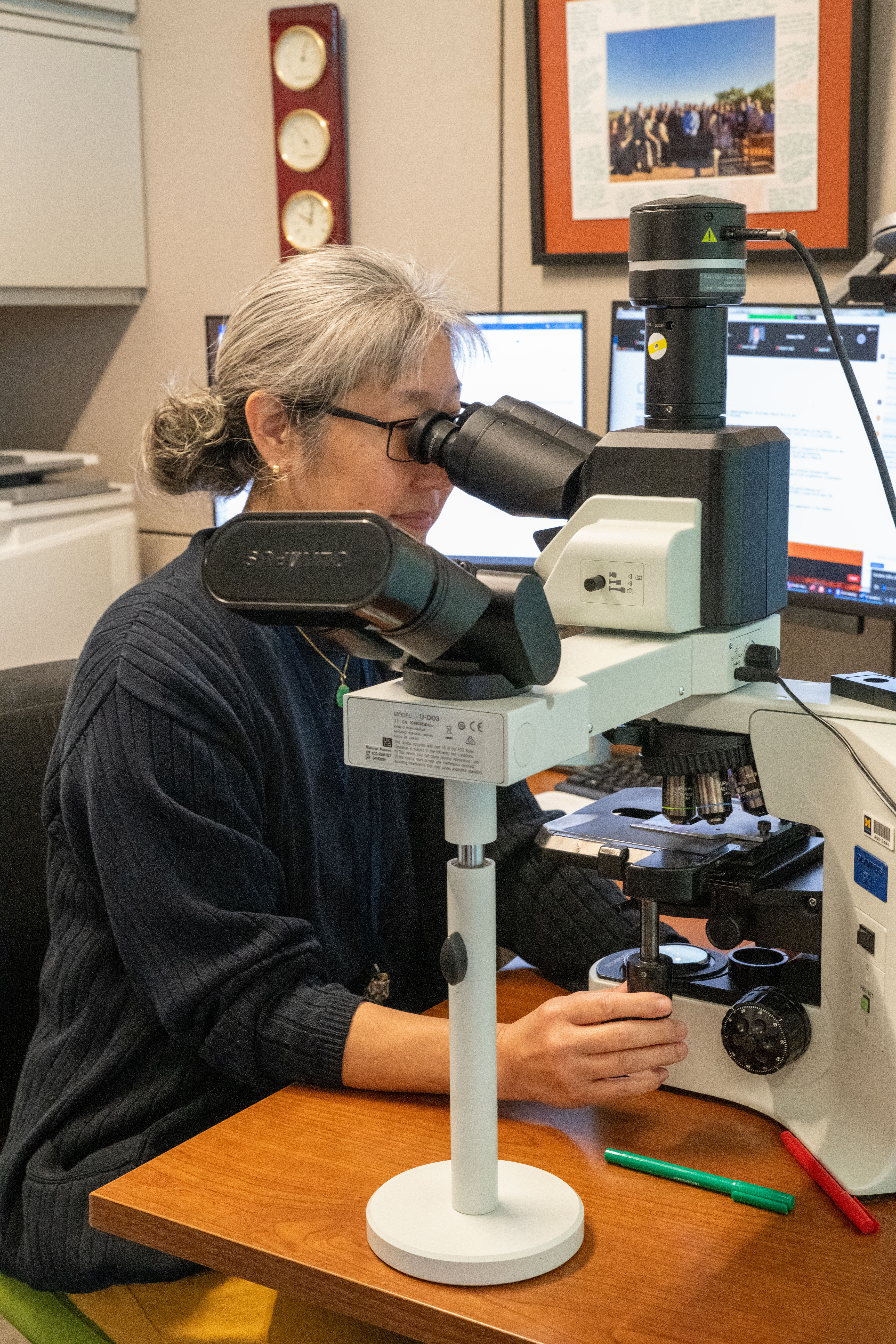 (1).png)
 (1).png)
As with many adults, the career path for the new Division Director for Molecular and Genomic Pathology, Annette S. Kim, MD, PhD, was not without its pivots. Kim was a chemistry major at Harvard University when she decided to continue her education there and obtain an MD with a PhD in synthetic organic chemistry, which focuses on designing and synthesizing biological relevant molecules and improving the existing methods of synthesis. This was followed by a postdoctoral fellowship in NMR structural biology at Memorial Sloan Kettering.
After her fellowship, however, Kim left academia for industry and took a position at Merck Pharmaceuticals Company, where she worked for several years leading a target validation effort prior to returning to medicine. “There was a bit of a push and a pull, and I realized that I really missed the clinical environment,” explained Kim. She considered carefully which field of medicine would be the best fit. Kim likes to think about medicine at the molecular level – how does the molecule work? Which field of medicine would bring to bear hardcore molecular biology, protein biology, and chemistry on patient care? “That is when a revelation hit me. Is this actually pathology? So, I took a leave of absence from Merck and spent three weeks at the pathology department at the University of Pennsylvania. At the end of those three weeks, I felt like, ‘these are my people.’ This is what I need to do.” She was accepted at the University of Pennsylvania pathology residency program and left her lucrative position at Merck. “I was pregnant at the time,” recalls Kim. “So, it was really an ‘awesome’ time to make a life-changing decision. I left my cushy job with high pay and good work-life balance to become a resident, but Penn was extremely welcoming and acknowledged that I had a unique background. I still had to learn the ropes from the ground up in pathology, but they accepted that I was coming in with a stronger research and leadership background than usual.”
 Kim focused her training on hematopathology and molecular pathology through her fellowships at Penn. “What I love about Pathology and chemistry is when you attain a deep understanding of how the molecules work, you can begin to think like a molecule. When I think like a molecule, I don’t have to just memorize reaction names or processes, because I can just intuit what will happen. When you understand something deeply enough, you can figure out everything else that you need to know. It all makes sense.”
Kim focused her training on hematopathology and molecular pathology through her fellowships at Penn. “What I love about Pathology and chemistry is when you attain a deep understanding of how the molecules work, you can begin to think like a molecule. When I think like a molecule, I don’t have to just memorize reaction names or processes, because I can just intuit what will happen. When you understand something deeply enough, you can figure out everything else that you need to know. It all makes sense.”
When Kim finished her fellowships, she spent a year as the medical director of the clinical labs at Cooper University Hospital, which is now a part of MD Anderson. She then spent 6 years at Vanderbilt and another 8 years at Brigham and Women’s Hospital. It was then she was approached by Michigan to consider becoming our Director of Molecular and Genomic Pathology. “I was at a stage in my career where it was very exciting to build and create. I didn’t have to be worried about my own career and wanted to be able to spend my time worrying about other people’s careers and helping them step into opportunities. This type of a role was the logical next step.” When considering various opportunities, Michigan stood out. “What was special about Michigan is they already had amazing people. Amazing laboratories were already present with great leadership in the labs. There was a team of unbelievably talented people who would be the ones to bring everything to fruition. I knew I could rely on that team to take us to the forefront of molecular medicine. Then there was the departmental leadership – the chair, the vice chairs, even Michigan Medicine as a whole, are backing us in our initiative. It is very exciting to have this much support from the entire institution to bring all our goals to fruition.” It was an offer she couldn’t refuse!
 The Division of Molecular and Genomic Pathology looks at the genomes of individuals at the molecular level to identify variants that could be determinants of human disease, whether that be germline (inherited) or somatic (acquired) disease such as cancer. Kim sees the field of Molecular and Genomic Pathology as moving into the future along two paths. The first is the shift from looking for individual mutations or lesions that cause disease into identifying patterns of lesions that cause disease. It is often multiple changes occurring in specific patterns that lead to disease instead of just a single mutation. This requires utilization of technologies that will allow very broad testing. To accomplish this, Kim plans to bring online large-scale sequencing tests, once of which is MiOncoSeq, which was developed in Pathology’s Michigan Center for Translational Pathology. This test allows pathologists to look at mutational signatures as well as individual mutations. It is capable of identification of structural variance, copy number variance, and expression analysis. The division also plans to bring on some new fast turn-around-time assays, assays that are capable of measuring residual disease, whole genome sequencing, and optical genome mapping as well. “This is an exciting new technology that extends beyond the capabilities of microarrays to structural variants, so it can provide a very holistic view of large-scale structural lesions in the genome.”
The Division of Molecular and Genomic Pathology looks at the genomes of individuals at the molecular level to identify variants that could be determinants of human disease, whether that be germline (inherited) or somatic (acquired) disease such as cancer. Kim sees the field of Molecular and Genomic Pathology as moving into the future along two paths. The first is the shift from looking for individual mutations or lesions that cause disease into identifying patterns of lesions that cause disease. It is often multiple changes occurring in specific patterns that lead to disease instead of just a single mutation. This requires utilization of technologies that will allow very broad testing. To accomplish this, Kim plans to bring online large-scale sequencing tests, once of which is MiOncoSeq, which was developed in Pathology’s Michigan Center for Translational Pathology. This test allows pathologists to look at mutational signatures as well as individual mutations. It is capable of identification of structural variance, copy number variance, and expression analysis. The division also plans to bring on some new fast turn-around-time assays, assays that are capable of measuring residual disease, whole genome sequencing, and optical genome mapping as well. “This is an exciting new technology that extends beyond the capabilities of microarrays to structural variants, so it can provide a very holistic view of large-scale structural lesions in the genome.”
In another shift, Kim sees a major role for Artificial Intelligence (AI) utilization in molecular and genomic pathology. She envisions it being used to gather data that is needed to aid in interpretation of that data. “I’ve seen it used in figuring out how other people have called a variant. It takes a variant and compares that across a number of pathologists and institutions to see how that variant was interpreted. It also conducts literature searches and sign-out searches. I can also see it being used in machine learning support for signature pattern recognition from whole genome data.” Across Michigan Medicine and other institutions, researchers continue to discover new patterns and mutations associated with human diseases. Kim hopes to integrate these novel algorithms into the division’s bioinformatic pipelines so that all this knowledge can be applied to clinical cases.
One of the biggest challenges with molecular and genomic pathology is the fast pace of change and being able to integrate that change into the laboratories quickly. “There is a wave of new assays coming down the pike. It is a daunting task to bring on all these new assays across the division.” Another major challenge is related to the vast amounts of data generated in molecular testing. Data storage, utilization, cloud processing, an overarching framework for tracking specimens, and sign-out user interfaces that back onto variant and interpretation databases represent an enormous need for a team with exceptional technical expertise.
The fast pace of change may be challenging, but Kim also finds it invigorating. “This field is at the cutting-edge of medicine and science and it is just a really fun spot to work in! It is the pride that you get when you bring on an assay and see its results and how those results impact patient lives. There is just so much invigoration and purpose associated with that.” This energy is brought forward to the residents and fellows who train under her. Kim loves to teach. “I love sitting with trainees and being able to teach them about what I do and to convey my joy about what I do to them. It is very exciting, especially when I can pass on that deeper understanding of how things work.”
In addition to clinical work and teaching, Kim has a rich background in research. Her publications include four primary areas of study. One body of work examines myelopoiesis and hematopoiesis from a molecular level, looking at micro-RNAs and their roles in hematopoiesis. This has been a major area of study for Kim with a number of publications that have identified micro-RNAs associated with the diagnosis, prognosis, and prediction of therapy response in patients with myelodysplastic syndromes.
Another significant area of research is test utilization management. In this area, she looks at reflex testing and testing algorithms to minimize healthcare costs while optimizing patient care at several institutions and throughout the VA healthcare system. She has also worked with the College of American Pathologists (CAP) to evaluate the quality of testing across the United States, looking at the practice and performance characteristics for testing for particular biomarkers and for NGS in general. With CAP, she has compared the performance of FDA-approved assays to laboratory developed testing, providing critical data to inform discussions about the testing regulatory environment. Similarly, as a member of the GOAL Consortium (Genomic Organization of Academic Laboratories), which is made up of experts from across the United States, she has led studies on academic molecular NGS practices and performance. Her final area of research is in looking at mutational patterns across myeloid neoplasms. “This has been a fruitful area of research conducted in collaboration with many wonderful people, including many through the Association for Molecular Pathology working groups. One working group focused on some chronic myeloid neoplasms and assembled mutational patterns together. This was a springboard for much of my interest in is area.”
 If an undergrad were considering molecular pathology as a career, Kim is enthusiastic about their opportunities. “They can’t go wrong with this field, if they love it and are passionate about it, because there are many, many avenues in which to engage this field.” One of these avenues is as a medical technologist. “Those are the miracle workers who actually make the data happen. They produce the results that impact patients’ lives. All credit goes to our amazing medical technologists. I encourage anybody to consider a field in medical technology if they enjoy doing things with their hands and minds and they love to take care of patients, their samples, and their data.” Another career option is that of a basic science researcher who develops the next generation of methodologies that are useful in this area. One can also go into medicine and become a medical director of a molecular laboratory or a pathologist. “Finally, many people start off in basic science and at a later point decide they want to come back and clinically apply their skills. We have a fellowship program in laboratory genetics and genomics where PhD scientists are able to train in clinical genetics and genomics and apply their scientific minds to the clinical arena as well.” Finally, they could enter the field as bioinformaticists, bringing the computationally oriented people to the field of medical informatics, software engineering, and bioinformatics.
If an undergrad were considering molecular pathology as a career, Kim is enthusiastic about their opportunities. “They can’t go wrong with this field, if they love it and are passionate about it, because there are many, many avenues in which to engage this field.” One of these avenues is as a medical technologist. “Those are the miracle workers who actually make the data happen. They produce the results that impact patients’ lives. All credit goes to our amazing medical technologists. I encourage anybody to consider a field in medical technology if they enjoy doing things with their hands and minds and they love to take care of patients, their samples, and their data.” Another career option is that of a basic science researcher who develops the next generation of methodologies that are useful in this area. One can also go into medicine and become a medical director of a molecular laboratory or a pathologist. “Finally, many people start off in basic science and at a later point decide they want to come back and clinically apply their skills. We have a fellowship program in laboratory genetics and genomics where PhD scientists are able to train in clinical genetics and genomics and apply their scientific minds to the clinical arena as well.” Finally, they could enter the field as bioinformaticists, bringing the computationally oriented people to the field of medical informatics, software engineering, and bioinformatics.
“I have been incredibly fortunate in my career,” mused Kim. “I have had great mentors in my life. First there was Dr. David Evans, at Harvard, who shaped my view of chemistry and how I think about the molecules of life. Then there is Dr. Deb Leonard, who is one of the forerunners in the field of molecular pathology. I met her when I took the leave of absence from Merck and came to the University of Pennsylvania to explore pathology. She saw me, reached out to me, and talked to me about my career options and opportunities. We still keep in touch and every time we run into each other, I have received tremendous mentorship from her. I am looking forward to paying that mentorship forward here at Michigan and seeing what we can all accomplish together!”